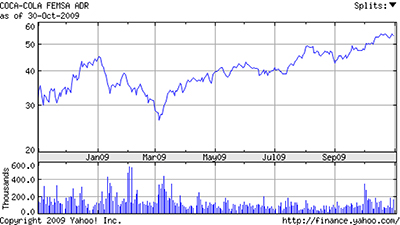In a statement Grupo Modelo reports that during the third quarter, total volume of beer sold reached 13.7 million hl, which represents a 3.2 percent increase compared with the same period last year. Volume in the domestic market totalled 9.4 million hl, which represents a 7.0 percent growth compared with the third quarter of 2008. Domestic brands were up 7.6 percent, benefitting from favourable weather during the quarter as well as the implementation of initiatives to improve execution in the market, the brewer says.
FEMSA, Mexico’s second-largest brewer behind Grupo Modelo, is holding merger talks with several companies. Its beer operations are officially on the table, but analysts expect all of FEMSA – which is also Mexico’s largest Coca-Cola bottler and the owner of the Oxxo convenience-store chain – could ultimately be sold as a single package. FEMSA’s current market capitalisation is USD 9.9 billion.
Mexico’s Government has proposed hiking the excise tax on beer to 28 percent next year from 25 percent, and is also seeking a new 2 percent sales tax on all goods and services as a way of recovering lost revenue from lower oil production, it was reported.
The MillerCoors Draught Training Center, located in Golden, features an extensive range of hands-on dispense training systems, stations and equipment integrated with a multi-media presentation environment, all dedicated exclusively to educating and training beer industry personnel in draught beer dispense.
Well, it was only a matter of time before stock market-listed FEMSA would spin off its beer business. FEMSA’s brewing unit, FEMSA Cerveza, has been overshadowed for years by its soft drinks division Coca-Cola FEMSA (KOF), the largest Coca-Cola bottler in Latin America.
Speaking on an earnings conference call on 1 October 2009, the company’s executives said the summer selling season for the U.S. beer industry was challenging, but that marketing efforts are starting to help sales stabilise at its joint venture. In order to boost sagging sales, Constellation has increased its promotional activities through increased media coverage and targeted marketing programmes. The company also plans to introduce new packaging options and will shortly launch a 24 oz. can of Corona Extra and Corona Light brands in the market.
The sale of the Busch Entertainment unit, which owns the SeaWorld and Busch Gardens parks, has long been expected as part of AB-InBev’s plans to pay for its USD 52 billion acquisition of Anheuser-Busch last year.
Perhaps it is because I happen to live in Mr Rumsfeld’s Old Europe that I wonder if this Blogger Culture, or Blog Fest, or Blogosphere is not just a lot of intense navel-gazing of zero relevance. If all that collected outrage that can be found on www.stltoday.com/blogzone/lager-heads/ really had an impact on how consumers feel about long-cherished beer brands, surely people would stop buying AB-InBev products.
The Justice Ministry will follow a recommendation from CADE, as the country’s anti-trust agency is known, and open an investigation of AmBev’s executives, Mariana Tavares, the ministry’s anti-trust division chief was quoted as saying. The probe could result in civil charges against the executives.




